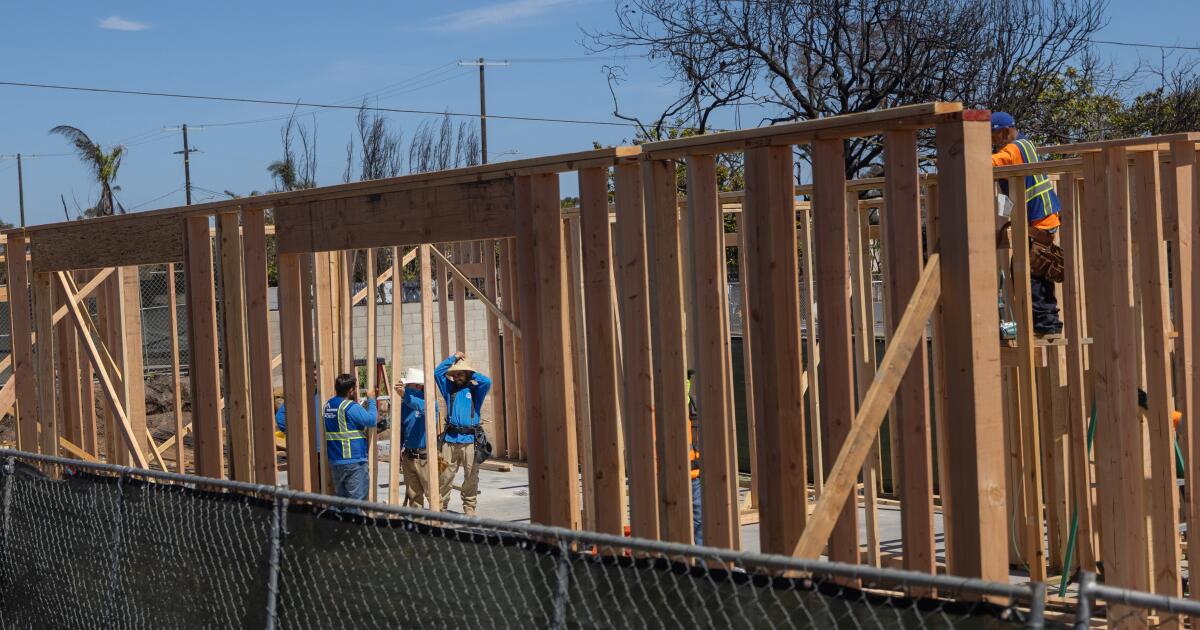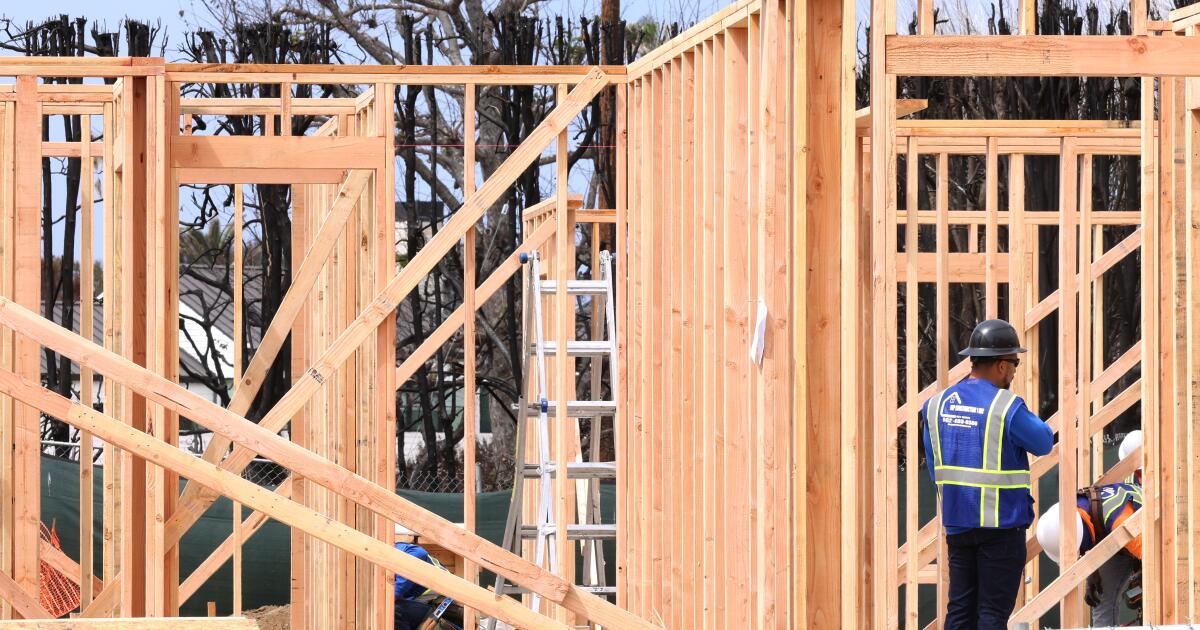After outcry, L.A. restricts duplexes in Pacific Palisades
As rebuilding ramps up in Pacific Palisades, Los Angeles leaders are restricting the building of duplexes on single-family-home lots.
The move follows an executive order issued Wednesday by Gov. Gavin Newsom that allows exemptions for the Palisades and other areas devastated by January’s Palisades and Eaton fires from Senate Bill 9. The landmark 2021 law, passed in response to the state’s housing shortage, lets property owners divide single-family-home lots and build up to four units.
In recent days, Palisades residents have raised alarms about SB 9, worrying that their historically single-family-home community would be transformed by the additional density allowed under the law and become more dangerous in the event of future fires. On Jan. 7, the chaotic evacuation amid the flames led residents to abandon their cars on Sunset Boulevard and escape on foot, forcing bulldozers to clear the road so that emergency responders could enter the area.
No outcry has erupted over the addition of accessory dwelling units in the Palisades, even though they could bring similar increases in building, and have been far more common in permit applications.
Some 4,700 single-family homes were destroyed or severely damaged in the Palisades fire, the majority of which were in the city of Los Angeles.
Newsom’s order applies to the Palisades and parts of Malibu and Altadena — areas that burned and that are designated as “very high fire hazard severity zones” by the California Department of Forestry and Fire Protection. It mandates a weeklong pause on SB 9 projects to allow the city and county of Los Angeles and Malibu to develop restrictions.
In response, L.A. Mayor Karen Bass, who alongside City Councilmember Traci Park had urged Newsom to act this week, issued an executive order blocking future SB 9 development in the Palisades.
“I thank Governor Newsom for working with my office to provide some sense of solace for a community working to rebuild,” Bass said in a statement accompanying the order.
Since the fire, the prospect of greater density, including increased affordable housing, has raised tension in the neighborhood. Some of the debates have been mired in misinformation and conspiracy theories falsely asserting that the wealthy community would be rezoned for mass building of low-income apartments.
But residents retain deep scars from January’s tumultuous evacuation and fear that such a situation would be even worse with a larger population, said Larry Vein, founder of wildfire recovery group Pali Strong. They also want the area to return to the predominately single-family-home neighborhood it was, he said.
“The community does not want higher density,” Vein said.
Officials’ push to restrict SB 9 construction stands in stark contrast to their efforts to allow more building on single-family-home lots through different means.
Newsom and Bass each issued earlier executive orders to streamline permitting reviews for accessory dwelling units on single-family-home properties in burn zones.
There are some practical distinctions between the two ways of adding homes. Generally, ADU law permits up to three units on a lot. SB 9 can allow four or potentially more if combined with ADU law. SB 9 units often can be larger than ADUs as well.
Yet the possibility of increased ADU construction has not attracted the same opposition in the community; instead, data indicate that it’s been popular.
The Los Angeles Department of Building and Safety does not specifically track permit requests for ADUs or SB 9 projects among home rebuilds, and could not immediately verify their numbers. However, department rebuilding data analyzed by The Times includes a description of each proposed development that is supposed to note if an additional unit is planned.
As of July 28, 500 homeowners had submitted permitting applications to rebuild in the Palisades, The Times’ analysis of department data found. Of those, 73 — nearly 15% — included at least one ADU, according to project descriptions. Per the descriptions, three intend to use SB 9, but that number is an undercount, said Devin Myrick, the department’s assistant deputy superintendent of building. Myrick said the department was still analyzing its data to come up with the actual number of SB 9 projects.
Property owners have cited ADU construction as a way to return to the Palisades more quickly, with some planning to build an ADU before tackling their primary home. For others, the opportunity for building any additional unit, under ADU law or SB 9, provides a financial benefit that could be used to cover gaps in the cost to rebuild.
Vein said Palisades residents are friendlier to ADUs because their construction may not necessarily lead to a larger population. Many people, he said, would use an ADU to work from home, as a guesthouse or allow members of multigenerational families to have their own space. By contrast, he said, SB 9 duplexes inevitably will add people.
“You’ve just doubled the density,” he said.
Some pro-development organizations are blasting the SB 9 restrictions. Matthew Lewis, a spokesperson for California YIMBY, which advocates for greater home building across the state, said that residents’ evacuation concerns are legitimate but that officials should focus on resolving that issue rather than limiting duplexes.
Lewis said the proliferation of ADUs in the area’s rebuild shows that it’s not actually the potential for increased building that’s motivating the opposition. Instead, he said community groups and L.A. politicians are using that argument to thwart a law they’ve long disliked because it expressly calls for changes to single-family-home neighborhoods.
“What we’re talking about is a powerful constituency making enough noise to cause a suspension of laws that were duly passed by the state Legislature,” Lewis said. “That’s very concerning.”
Bass believes her backing of ADUs and opposition to SB 9 in the Palisades do not conflict, mayoral spokesperson Zachary Seidl said. SB 9 was not anticipated to be used after a major wildfire, he said, while streamlining ADU permitting assists property owners with reconstruction.
“The mayor with both of these positions is supporting community members in the Palisades rebuild,” Seidl said.
Times staff writer Doug Smith contributed to this report.

